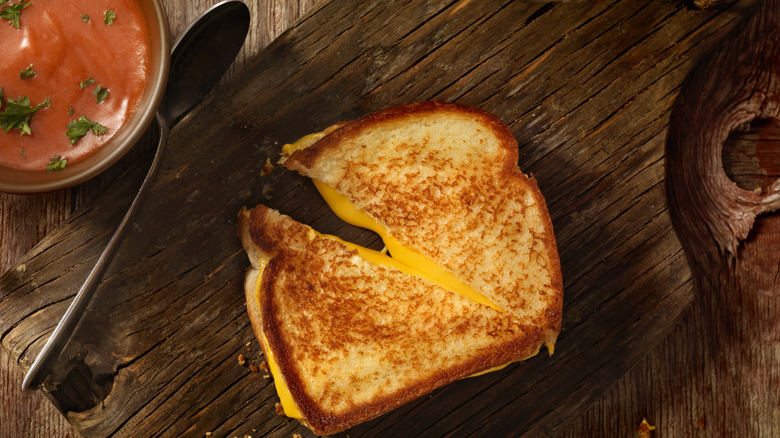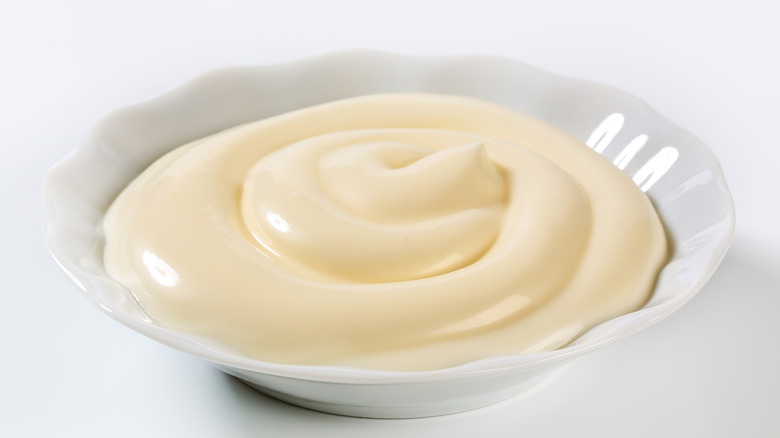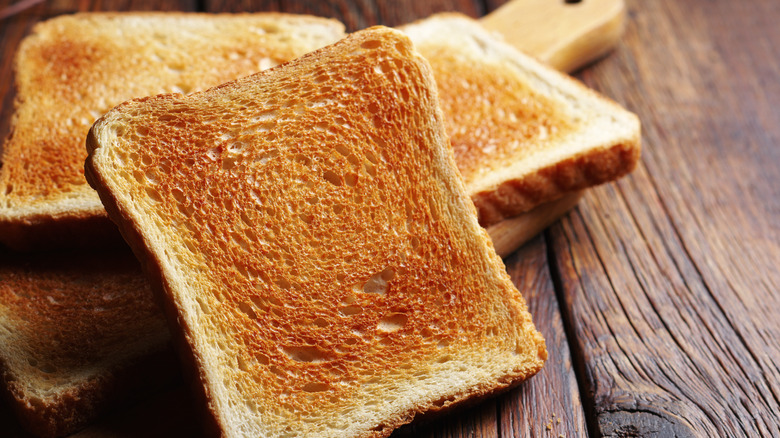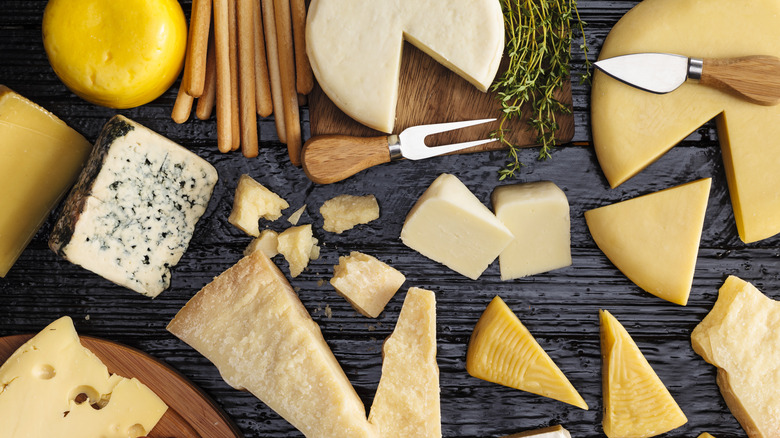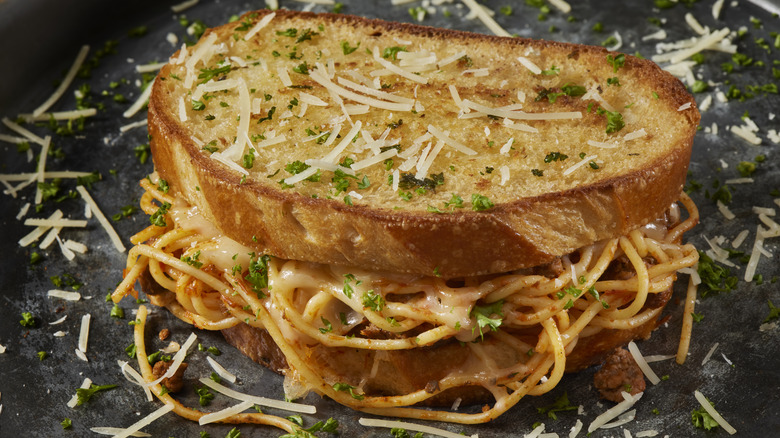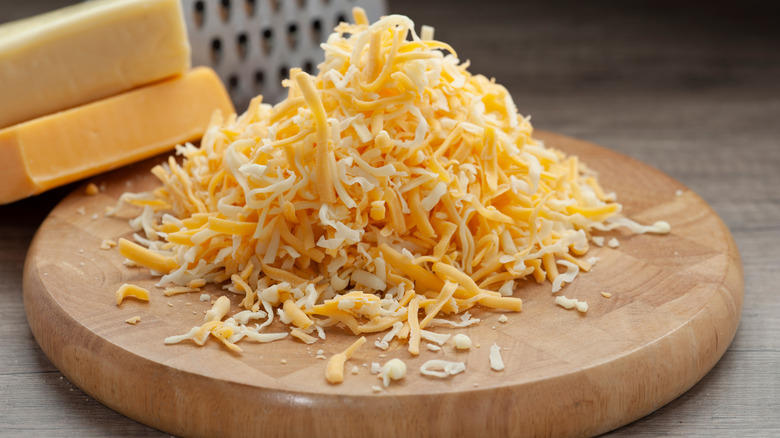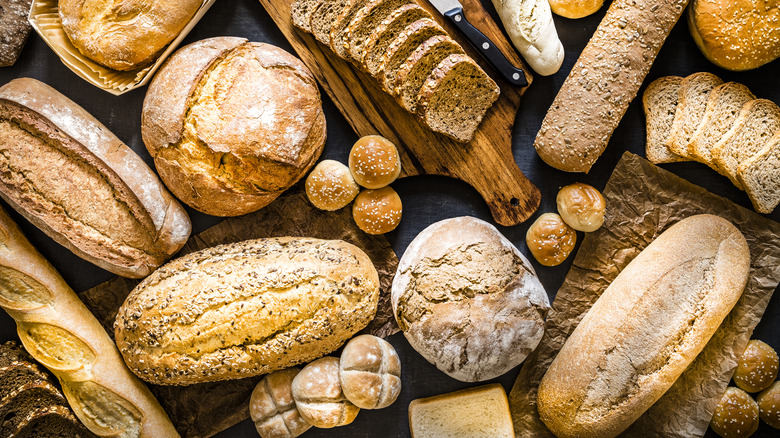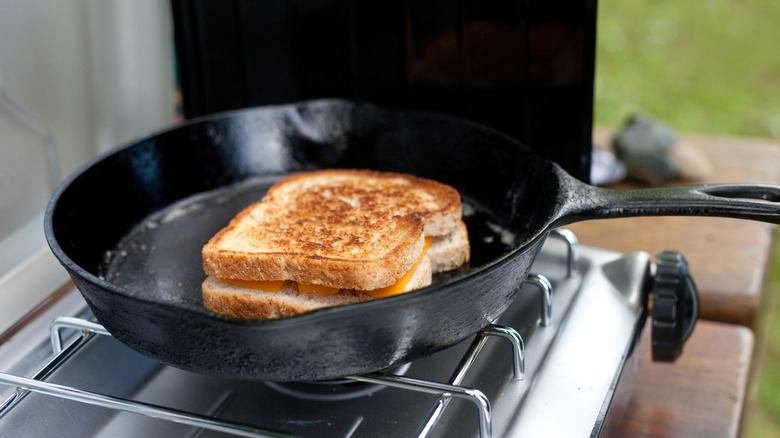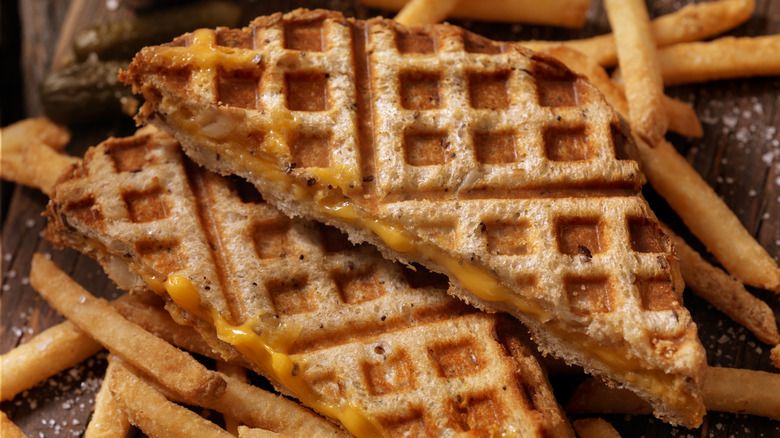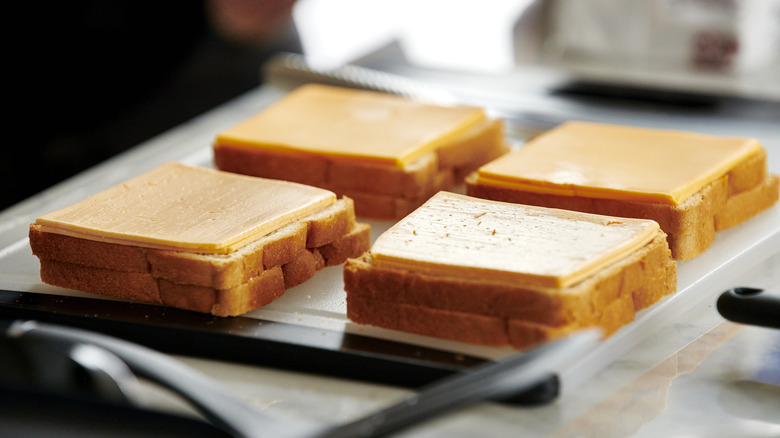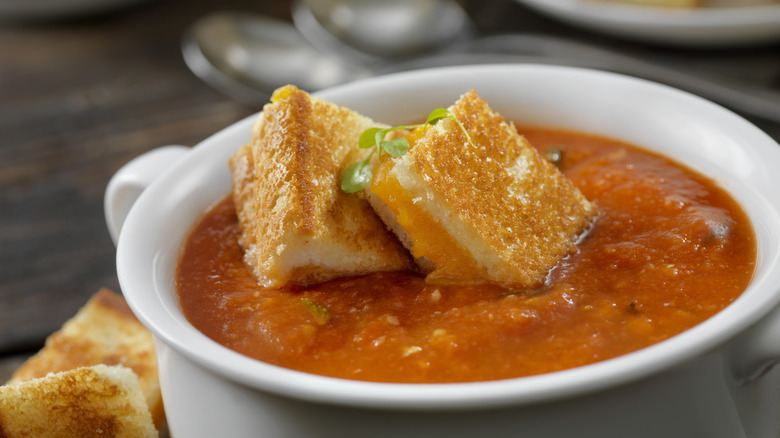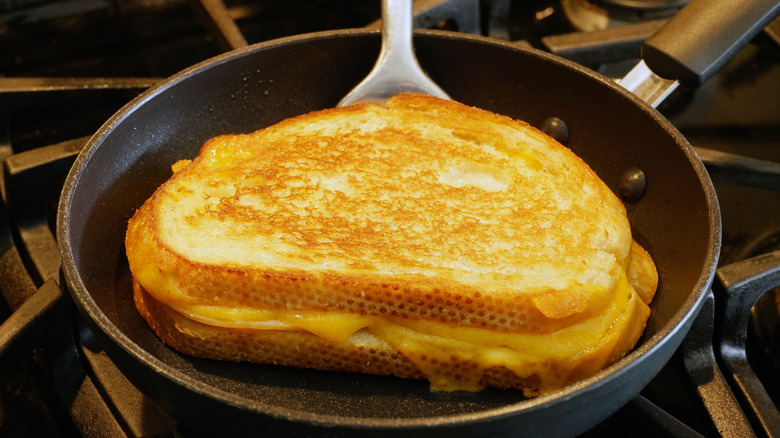Stop Making These Mistakes With Your Grilled Cheese Sandwich
Grilled cheese is arguably one of the most satisfying sandwiches on the planet (especially when someone else lovingly makes it for you). It's elemental, this combination of bread and cheese melded together with heat and fat — and many cuisines across the globe all have some variation of it. Whether you prefer the traditional white bread-American cheese pairing or like to experiment with flavors, there's lots to love about a grilled cheese sandwich.
But even the most well-intentioned cooks struggle with the ingredients and techniques of this deceptively simple food. Getting the perfectly gooey cheese and crispy, golden bread is not as easy as you might think, and it's possible to make a sandwich that's just meh.
Fortunately, grilled cheese is forgiving. Even a meh sandwich is still pretty good, and it's fast to make another one if the first one doesn't do the trick. Spare yourself the time and trouble: Here are 11 of the biggest mistakes you are making with grilled cheese (and what to do about them).
Thinking butter is the only option
Butter is the classic coating for grilled cheese, lending a familiar flavor that, when cooked properly, is also great for getting that golden, buttery glow. But it's not the only option, and it's not even the best option when it comes to adding flavor and texture.
One easy swap is mayonnaise. The oil and egg in mayo create a great crunch, and the vinegar and mustard bump up the flavor. It has a high smoke point (450 F, a full 100 degrees higher than butter), which means there's less danger of burning your sandwich in a too-hot or unevenly heated pan.
If your grilled cheese frequently burns no matter what you do, consider using clarified butter (also called ghee). This fat has no milk solids and an even higher smoke point than mayonnaise. The flavor is slightly nutty, the perfect grounding complement to a wide variety of cheeses. Finally, if you're feeling adventurous, give coconut oil a try. This vegan option has a mild flavor that's a slight departure from other fats — if you're concerned about the taste, select a stronger cheese.
Regardless of which fat you choose, don't neglect to season your sandwich. Some cooks season with salt (and sometimes pepper) right after the sandwich is finished, while others season the filling and then the sandwich itself. Remember that the goal is a salt level that lifts each flavor, not a salty sandwich.
Using untoasted bread
If your grilled cheese is chewy rather than crispy, slightly bland instead of lusciously flavored, start with the bread. Yes, you're frying the outside of the sandwich and melting the cheese in the process, but what about the bread surface inside? If you're using untoasted bread, you're missing an easy upgrade in terms of both flavor and texture. And making a grilled cheese without toasting the bread first can result in a limp sandwich.
Toasting your bread brings out a deeper flavor and performs another vital service. Melting cheese releases oil that can soak the bread and cause it to become soggy without actually cooking. When your bread is toasted, moisture is blocked, preventing a floppy sandwich. Plus, adding cheese to bread that's already hot melts your cheese faster, which means you get your sandwich sooner.
Toasting your bread doesn't even require a toaster. Toast your bread on the stovetop for grill marks and a slight char, or turn on your oven and toast directly on the rack (a good option for batch-baking grilled cheese, too).
Sticking with one cheese
American cheese is the standard dream of the perfect grilled cheese. It melts beautifully, and because of its uniform size, it is easy to customize in terms of the amount. There is science behind why American cheese is a great choice — the emulsifying salt added in its manufacture keeps it gooey as it melts. But American cheese is not the only choice, and sticking with one cheese means a one-note flavor profile that might be good for kids but less satisfying for grown-up palates.
Using more than one cheese bumps up the flavor, but the key is to select cheeses that work together and have a good melted consistency. Alton Brown prefers a combination of Gruyère and sharp cheddar, but there are any number of combinations that work in terms of taste and texture. Fontina, provolone, gouda, any Jack cheeses (i.e., Colby or pepper), brie, and Havarti are all brilliant. You can also add a new creamy element by mixing shredded cheese into cream cheese in a play on that Southern staple pimento cheese.
Limiting your filling options
It bears repeating: There is exactly nothing wrong with a traditional grilled cheese with white bread and a couple slices of American cheese. But limiting your filling options can get tired after a while. Don't you want to try something new? When you're ready to elevate your grilled cheese, the possibilities are nearly endless.
Adding a few ingredients can take your grilled cheese to the next level. For a play on the French grilled cheese (aka the croque monsieur), skip the béchamel and use roasted red peppers and Gruyère or Emmentaler to capture the spirit instead. Add caramelized onions, kimchi, and cheddar for a salty-sour-sweet combination.
When expanding your grilled cheese sandwich repertoire, consider how your ingredients would combine if they were not a sandwich. Start with the cheese base (say, mozzarella) and then move on from there (a swipe of pesto and chopped sun-dried tomatoes, finished with a drizzle of balsamic for a twist on Caprese salad). You can turn nearly anything into a grilled cheese sandwich: Mac and cheese, spaghetti, and Thanksgiving leftovers are all good candidates, too.
Whatever you do, avoid using only hard cheese in your filling (such as parmesan and asiago). These provide a lovely, deep flavor but won't melt. It's okay to add a sprinkling of hard cheese as a flavor component, and you can take your grilled cheese up a level by crusting your bread with it. This adds a deep salty tang and crunch to the sandwich.
Adding the wrong amount of cheese
The amount of cheese matters. Too little, and it's barely a grilled cheese. Too much, and your cheese-to-bread ratio is spoiled. The key here? Don't skimp, but don't overdo it. You need the Goldilocks amount — just right — for the perfect ratio of cheese to bread.
If you're using pre-sliced American cheese, three slices should do the trick, but shredded cheese is a little trickier. Depending on the type of cheese you use (and any additional fillings), a good guide is to use 2 to 3 ounces of cheese (¼ to ⅓ cup), whether sliced or shredded. If you love cheese, it's okay to stay on the high end of that range. But don't make the mistake of packing your sandwich. Too much cheese melts unevenly, leaving you with a hidden pocket of cold, stringy cheese.
Don't veer the other way, either. If you are cutting down on cheese to watch calories, consider low-fat cheese options like mozzarella and choose lower-calorie options for the outside of the bread (although not ideal in terms of flavor, zero-calorie cooking spray works in a pinch). You can also make an open-faced grilled cheese and cut back on calories that way.
Choosing only white bread
Nothing against this staple of the basic grilled cheese, but there are so many other delicious bread options. Changing up your bread game is the quickest way to add interest to an otherwise serviceable daily sandwich. Something as simple as replacing store-bought white bread with artisanal (or homemade) sourdough adds a whole different dimension in terms of flavor (and texture).
But don't stop there. To pay homage to grilled cheese across the globe, consider arepas as your sandwich casing. Arepas are humble South American breads easily made with masarepa, water, oil, and salt. A quick mix and rest of the dough and they are ready to be fried, split, and filled with your cheese of choice.
Flatbreads from various countries do a great job of standing in for plain bread. For starters, naan is an excellent swap. These garlicky flatbreads stand up to strong cheeses and complex fillings. The texture is wonderfully chewy. For another solid stand-in, head west to Italy for a salty, olive-oil-finished focaccia. Split one in half or layer two for batch baking. Because focaccia is usually finished with a generous glug of olive oil, you may not need any fat on the outside of the sandwich.
Not understanding basic cooking techniques
Ask Gordon Ramsey: Even professional chefs get grilled cheese wrong from time to time. He's been lambasted for everything from the type of cheese to the cooking technique in a video of the master chef making grilled cheese. This terrible grilled cheese advice is shocking from an expert, but even the best have their off days.
Mastering the basic cooking techniques for grilled cheese includes first understanding the correct temperature. Newbies get their pan searing hot and toss their sandwiches in. This leads to a burnt crust and unmelted cheese. Grilled cheese is best cooked like barbecue: slow and low. Heat your pan to a medium temperature, then add your grilled cheese and turn it down to low.
Once it's in the pan, don't fuss with your sandwich too much. Give it about three minutes before you check to see if the bottom is golden brown, but don't rush. Color is flavor, so let the sandwich get a nice tan before you flip.
After the flip, use your spatula to press down firmly. This melds the cheese to the bread. When you've pressed firmly, cover the pan with a lid for the final minute or two so the cheese melts as the bread crisps up. The total cooking time should be around seven minutes.
Only using a frying pan
Your frying pan is a kitchen workhorse, capable of many tasks, which is likely why it's the thing you reach for most often — including when making a grilled cheese. But if you're only using a frying pan, you're missing out on some cooking techniques that dramatically change the quality of your grilled cheese.
Grilled cheese sandwiches can definitely waffle. Making one in a waffle iron means more golden, buttery, crispy edges. It's also easy to use your waffle iron to portion a grilled cheese for smaller appetites (just cut along the waffle iron's natural divide).
Another great option that adds flavor and a bit of a rustic, outdoorsy vibe is actually grilling your grilled cheese sandwich. Not only does it give aesthetically pleasing grill marks; the grill also adds a hint of smoky flavor that works great in combinations like Gouda and apples. Not a fan of cooking outside, or not in possession of a grill? A panini press can give much the same result minus the smoky undertones.
An air fryer is another option for a laissez-faire grilled cheese. For best results, you'll need to make the sandwich open-faced and combine it when it's on the plate. If you have a flexible bread (such as naan), you could technically treat it as a wrap, keeping it whole in the air fryer until it's crisped.
Taking too long to make multiple sandwiches
When a crowd of hungry folks is gathered around the table, the last thing they need is to watch the cook make one painstaking sandwich after another. In a group of five, the last person eating will have waited 35 minutes to be fed — this could end in mutiny. But it's batch baking to the rescue! Batch baking is how professional chefs feed hundreds of people all at once, and it's easy to adapt to grilled cheese.
You'll need a rimmed baking sheet (to catch runaway melted cheese) and an oven preheated to 400 F. Assemble the bottom of the sandwiches — let's say you're making five at a time — with bread that has butter, mayo, or other fat on it and is topped with cheese. Add another slice of bread (also buttered or mayo'ed) and bake for a total of 10 minutes. Flip the sandwiches halfway through, and use a spatula to press down on each sandwich after you flip it.
If you've got a group with different food preferences or dietary restrictions, this way of making grilled cheese can help. Each sandwich can be customized for the person who needs it (i.e., vegan cheese, gluten-free bread, and so on).
Sticking with a sandwich
If the soup-and-sandwich combo is your go-to meal, things can get a little tired. Shake it up by skipping the full-sized sandwich and making grilled cheese croutons instead. There are two ways to make this magic happen.
The first way is to prepare a standard grilled cheese. When you design your filling and bread, make sure that flavor profile matches the soup you'll be eating — excellent soups for grilled cheese croutons are traditional tomato or broccoli cheddar. Once your sandwich is crispy, let it rest (see below), then cut the sandwich into smaller cubes. This works great if you just want to tuck in.
But to go one further, add a bit more fat on each side of the smaller grilled cheese croutons and brown the sides in the pan. This extra step seals the edges, prevents the cheese from flowing out, and crisps up the edges of the bread so that it does not become soggy when floated on soup. The extra browning adds another texture to soup — a welcome addition when paired with smooth or creamy soup.
Eating grilled cheese straight out of the pan
For the last seven minutes you've been smelling the tantalizing aroma of melting butter and gooey cheese — you're hungry. It's tempting to snatch that sandwich right out of the pan and shove it in your face the instant it reaches the perfect temperature. But good things come to those who wait, and grilled cheese is no different.
Sure, hot food should be served hot, but waiting a few minutes before diving in allows two things to happen. The most important benefit is that waiting a minute or two after the sandwich is done allows the cheese to set slightly. This keeps your fillings inside the sandwich when you cut it (on the diagonal, of course).
The second reason is a safety issue. It may seem silly, but melted cheese is scalding. Soft cheeses have a lower melting point (between 90 and 150 F), but it's possible to burn your mouth (or your hand) on a freshly grilled cheese sandwich even at lower temperatures. Waiting for 60 seconds with the grilled cheese out of the pan allows for some cooling and is especially important if you cook for small children.

